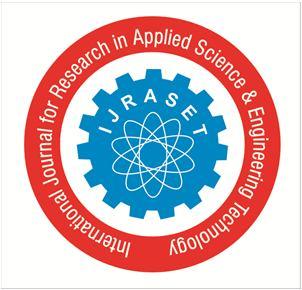
3 minute read
International Journal for Research in Applied Science & Engineering Technology (IJRASET)

ISSN: 2321-9653; IC Value: 45.98; SJ Impact Factor: 7.538
Advertisement
Volume 11 Issue IV Apr 2023- Available at www.ijraset.com
Recommendations: Keep the Spot extractor as possible to the activity ehile performing the activity
Keep the Spot extractor as possible to the activity ehile performing the activity
Place the LEV hood near to material handling area
Coonect a flexible duct to the up to equipment to increase the capture velocity
Obsevation: Distance between the material handling area and LEV hood was major contributory for the lesser capture velocity
Recommendations: Locate the LEV hood at a minimum possible distance from the material handling area.
Observation: Capture velocity was measured near TD which was approximatly 2 feet from the LEV hood place the LEV hood near to TD
Recommendations: Ensure the spot extractors are palced as near as possible to the location of activity at the Hood to increase the capture velocity
ISSN: 2321-9653; IC Value: 45.98; SJ Impact Factor: 7.538

Volume 11 Issue IV Apr 2023- Available at www.ijraset.com
Based on the above integrated industrial hygiene program implementation in Pharmaceutical Industries Employees who working in Manufacturing plant has to follow the following Hazards Control Measures;
1) Air Sampling Risk Control Plans:
Make engineering or administrative controls more effective, where feasible, such as local exhaust ventilation, and scrubbers. Where necessary to reduce exposures below the OEL, use protective equipment or other protective measures.
Use all available work practices to control dust exposures, such as water sprays.
Wear only fit tested respirators, if respirator protection is required. Do not alter the respirator Make, model, size once a fit test is completed. Do not wear a tight-fitting respirator with a beard or mustache that prevents a good seal between the respirator and the face.
Wear disposable work clothes and take a shower if facilities are available. Vacuum the dust from your clothes or change into clean clothing before leaving the work site.
Participate in training, exposure monitoring, and health screening and surveillance programs to monitor any adverse health effects caused by crystalline silica exposures.
Be aware of the operations and job tasks creating exposures in your workplace environment and know how to protect yourself.
Do not eat, drink, smoke, or apply cosmetics in areas where dust is present. Wash your hands and face outside of dusty areas before performing any of these activities.
2) Hazard Characterization Recommendation:
Ensure that the chemicals which are dispensed in containers are provided with label having its name, CAS Number, EC Number, signal word, GHS Pictograms, emergency contact number, hazard classification, hazard statement, precautionary statement/first aid on the container before taking it in to use.
For mixtures and alloys – label should include chemical identities of all ingredients or alloying elements that contribute to acute toxicity, skin corrosion or serious eye damage, germ cell mutagenicity, carcinogenicity, reproductive toxicity, skin or respiratory sensitization, or specific target organ toxicity (STOT).
Where a substance or mixture is supplied exclusively for workplace use, competent authority may choose to give suppliers discretion to include chemical identities on the MSDS, in lieu of including them on labels. Vendor also should be asked for same format for Incoming Chemicals.
If the skull, corrosive symbol and Health Hazard symbol for respiratory sensitization applies, the exclamation mark should not appear [as used for acute toxicity, Skin or Eye irritation and skin sensitization].
Ensure that the labels of hazardous chemical empty containers are not removed or defaced until the container is decontaminated and disposed.
Ensure that the labels should visible, firmly attached at least one side of the container with indelible writing and readable position on container and illegible labels are replaced.
3) Noise Risk Control Plans:
Engineering Controls – Effective Acoustical Enclosure, Sound dampening and Absorption, anti-vibration mounts.
Administrative Controls
Use of Hearing Protection Device-considering the Noise Reduction Rating (NRR)
PPEs to be used in case of Noise level higher than 85 dBA.
Personal Protective devices provided to operator NNR rated 21 dBA and NRR rated 29 dBA ear muffs and Ear Plugs respectively.
4) Air Velocity Risk Control Plans:
Keep the Spot extractor as possible to the activity while performing the activity.
Connect a flexible duct to the up to equipment to increase the capture velocity.
Locate the LEV hood at a minimum possible distance from the material handling area.




